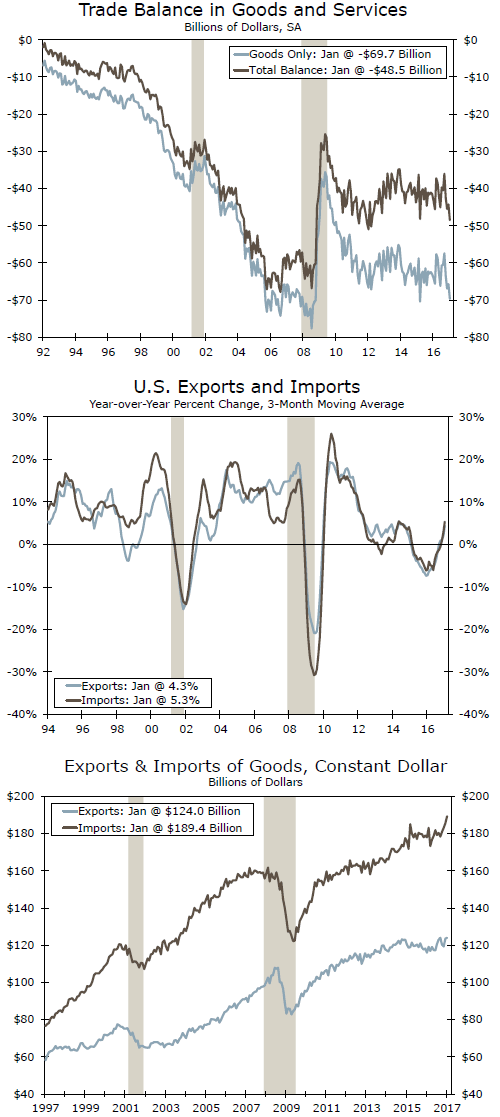Exports and imports appear to be turning around. Unfortunately for U.S. GDP growth, however, real imports are growing faster than real exports at present.
Real Net Exports Continue to Exert Drag on GDP Growth
The U.S. deficit in international trade in goods and services widened to $48.5 billion in January from $44.3 billion in December (top chart). The outturn came as little surprise because preliminary data on goods trade that were released last week indicated that an increase in the overall trade deficit in goods and services was in the cards. Although the value of exports rose by $1.1 billion in January, the deficit increased sharply due to the $5.3 billion jump in the value of imports of goods and services.
Some of the increase on the import side of the ledger reflects higher imports of petroleum products, which were up by $2.6 billion in January. That said, there was broad-based strength in imports in the first month of 2017, with capital goods ($668 million), auto vehicles and parts ($899 million) and consumer goods ($2.4 billion) all higher on the month. Overall exports would have been stronger had exports of civilian aircraft and parts, which are notoriously volatile on a monthly basis, not dropped $1.2 billion in January. Outside of capital goods, the other broad categories of exports were either essentially unchanged or higher on the month.
Taking a step back from the volatility that is inherent in monthly data shows that growth in exports and imports is starting to pick up again. As shown in the middle chart, the value of exports in the November-to- January period was up 4.3 percent on a year-over-year basis. The value of imports grew 5.3 percent during that period. Some of this acceleration in export and import values reflects higher commodity prices in recent months. That said, growth in real exports and real imports have strengthened as well in recent months. This pick-up in real export growth is consistent with signs of stronger economic growth, at least on the margin, in many of America’s major trading partners. Domestic demand in the United States, which influences real import growth, has also been generally resilient recently.
Speaking of real measures, real exports of goods rose 0.4 percent in January, which follows on the heels of the 3.6 percent gain in December. In other words, export growth entered 2017 with a fair amount of momentum. Unfortunately for U.S. GDP growth, however, there is even more momentum on the import side of the ledger as real imports of goods have grown in excess of 1 percent per month over the past four months (bottom chart). Real net exports sliced 1.7 percentage points off of overall GDP growth in Q4-2016 as real exports fell 4.0 percent while real imports jumped 8.5 percent. Although real net exports likely will not depress overall GDP growth in Q1-2017 as much as they did last quarter, the drag from the external sector could amount to as much as a full percentage point of GDP growth due to continued strength in real imports.













